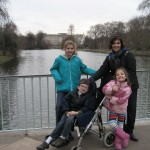Six weeks after our second child, Ben, was born, in 2001, I received my PhD in Health Psychology from King’s College London. That same day I won the “best pie” award at 3-year-old Lucy’s Montessori preschool in Birmingham, Michigan. The winning pie, the first and last “Lucy’s Luscious Lemon Meringue Pie”, was deemed perfect by the professional chef judges for its beads of water on the meringue. I thought these beads had been a flaw and didn’t even bother putting my name to the pie out of shame. I truly can’t decide what was a bigger honor that day. I had worked years for that PhD, but I expected to receive it; I had never made a lemon meringue pie, and I thought I was completely foolish for attempting the pie solely due to the cool alliteration it provided.
This blog is about these perceived boundaries between domestic and work life–and the occasional synergy, as the PhD diploma/pie winning day exemplified.
These boundaries became even greater when during 2001-2002 my husband and I began to realize that Ben’s physical development was not normal. I was unusually linked to the clinical genetics world through research that involved examining health care providers’ and patients’ perspectives of genetic conditions and how providers communicated these diagnoses to patients. Through wonderful colleagues and friends, our family found our way to Johns Hopkins Medical Center in Baltimore, Maryland, where amazingly generous, world-renowned physicians gave of their time and energy to determine what was causing Ben’s unusual musculature and skeletal growth, his dislocated lenses that left him legally blind and his strident breathing that kept everyone, and especially Ben, awake at night.
The answer: Schwartz-Jampel syndrome, an extremely rare, autonomic, genetic neuromuscular disorder, of which, in 2003, only 86 cases had ever been reported.
It took nearly two years, three states, and seven hospitals and more clinicians than I can remember to arrive at this diagnosis. I was in the middle of a postdoctoral fellowship in health services research, and was expected to rise to the challenge of grant-writing, publishing, teaching and networking with more esteemed colleagues at national conferences. Raising two (now three) children in academic medicine was always going to be tough; having to master the world of neuromuscular disorders, Ben’s countless therapy appointments, weekly medical appointments, lab tests, ER visits, extensive surgeries and recovery periods, durable medical equipment needs, health insurance regulations and more added an entirely new, complicated layer to the mix.
I first faced these issues through expressing my grief and dissatisfaction about our journey in academic medicine journals. While writing these articles was cathartic, they didn’t further my career. I dabbled with doing research in pediatric disability services–this soon became too close to home.
I became clinically depressed, and while in recovery, I turned my research attention to the need for more mental health care services in primary care. I realized that patients’ own perceptions of their mental health and treatment options were often stopping them from seeking and receiving treatment. This became a viable research agenda, and helped spring me from the depths of despair to academic stability.
I then drew on a pivotal experience for the next research agenda: in 2006, a week after Ben’s tracheostomy surgery, a beloved surgeon explained empathically to me that Ben had suffered an unanticipated complication of his surgery and that the surgery would need to be repeated. As a health communications researcher, I was amazed with this surgeon’s skills, his ability to explain this problem while keeping me calm, and how his care for Ben was so evident in how well he treated all of us. I realized then that if all surgeons could communicate unexpected surgical events as well as this surgeon, that patient trust in the physician could be retained, satisfaction could remain high despite the traumatic event, and that care could remain seamless and of high quality. I now lead two studies where this type of communication is examined.
I have taken the cues from my personal life to devise a path in my work life. This is where the synergy comes in. There are no boundaries.
And now that I have that synergy, I’m ready to talk about life in general with a child as unique as Ben. Thinking about the boundaries that Ben may experience is connected to everything I do, to what our family does, and how we all view daily life. He may have wheels (a power wheelchair and a walker), he requires skilled nursing services to manage his tracheostomy at school, and he relies on assistive technology to keep the education playing field level. But there are no boundaries to what he will accomplish in life. And there are definitely no boundaries to the lengths I will go to make sure he experiences life as fully as any able-bodied person.
Please join me in exploring the boundary-less plains of our lives–our travels near and far; the music Ben is involved in; the sports he participates in; the worlds of his sisters Lucy and Charlotte and how they learn from and also help Ben daily; and how my work in health services research, health communication and health policy and management intersects regularly with my personal life. I used to fight this intersection and now I embrace it. This blog is my newly found embrace.

